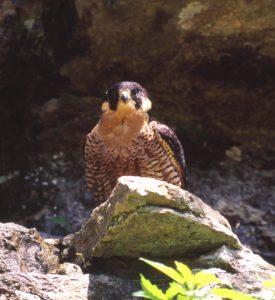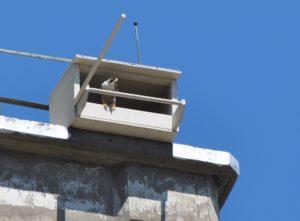Photography courtesy of Lowell Washburn, all rights reserved.
Iowa Peregrines Soar to New Heights
Following decades of absence, Iowa’s fastest bird species is staging a remarkable comeback. Peregrine falcon numbers continue to soar. During 2015, a total of 20 active falcon territories have been documented in the state so far – marking an unprecedented increase of five adult pairs over last year’s nesting season. During 2014, wildlife biologists inventoried a total of 15 active peregrine territories. Thirteen of those pairs were successful; producing 34 young falcons last summer.
With dives exceeding 250 mph, the peregrine falcon is credited with being the planet’s fastest bird. Historically, the rugged blufflands of the Upper Mississippi River provided a population stronghold for high flying, cliff nesting falcons. In spite of extensive human development, river populations remained stable until the late 1940s. But things changed rapidly following World War II as the widespread use of DDT pesticides began to exact a devastating toll on American bird life. As top of the food chain predators, peregrine falcons suffered more than most. Toxins accumulated. Egg shells thinned. Reproduction failed. By the early 1960s, peregrine populations were in free fall and scientists predicted the species’ extinction – possibly by the close of the decade.
Iowa’s last known peregrine nest [eyrie] was located on a cliff face near Lansing. Following a series of failed nesting attempts, both adults eventually vanished. After that, no peregrine falcons — not so much as a single bird — could be documented anywhere from the Mississippi River to the Atlantic Ocean. For mid-continent peregrine falcons, the horrific prophecies portrayed in Rachel Carson’s Silent Spring had become a stark reality. In the blink of an eye, the spectacular aerial hunters were gone.
Times change. Today – as the result of a complete ban on the use of DDT pesticides coupled with successful captive breeding projects initiated by American falconers – modern day generations of New Age peregrines are accepting the synthetic cliff nesting habitats of big city office buildings, urban bridges, and power plant smokestacks. Best of all, nesting falcons are returning to reclaim the historic cliff ledge sanctuaries of the Upper Mississippi.
Iowa has been the only state to successfully release captive produced fledgling peregrines into wild Mississippi river habitats. During a three year [1998- 2000] joint venture between the Iowa DNR, nongovernmental organizations and Iowa falconers; a total of 77 captive reared fledgling peregrine falcons were released on the Mississippi. Free flying descendants of those birds continue to grow in number; bolstering populations throughout the mid-continent region. In Iowa, peregrine populations now exceed [known] historic levels.
At least one of the original alumni from the Iowa releases is still on the wing, alive and well. The bird is a male that [as a 42-day-old fledgling] was banded and released on a 200 foot Dubuque cliff face by fellow falconer Tom Deckert and I during the summer of 2000. In 2002, the falcon returned as an adult to claim a territory at Davenport where he and his mate [a banded female from Muncy, Indiana] have been raising young each year since. At fifteen years of age, the Davenport male [marker band Black P / Green D] has become Iowa’s oldest breeding peregrine. His portrait hangs on my office wall; a fond reminder of an exciting and historic endangered species recovery.





 Tom Cope
Tom Cope Sue Wilkinson
Sue Wilkinson Susan Judkins Josten
Susan Judkins Josten Rudi Roeslein
Rudi Roeslein Elyssa McFarland
Elyssa McFarland Mark Langgin
Mark Langgin Adam Janke
Adam Janke Joe Henry
Joe Henry Kristin Ashenbrenner
Kristin Ashenbrenner Joe Wilkinson
Joe Wilkinson Dr. Tammy Mildenstein
Dr. Tammy Mildenstein Sean McMahon
Sean McMahon